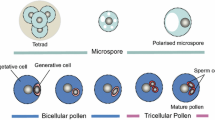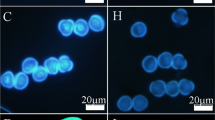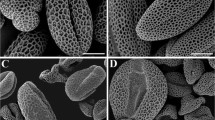Abstract
Key message
Pollen mRNAs were different in reciprocal F 1 hybrids, which were probably caused by a cytoplasm–nuclear chromosomal genes interaction.
Abstract
We have found reciprocal differences in crossability between F1 hybrids of Solanum tuberosum (T) and a Mexican wild potato species S. demissum (D). When the reciprocal hybrids were crossed as pollen parents with S. demissum, a significantly higher berry-setting rate was obtained in TD compared with DT. In this study, we performed a whole-genome transcript analysis of the pollen mRNA using a high-throughput sequencer. We obtained 12.6 billion bases that were aligned into 13,020 transcripts with 9,366 loci. All possible genetic modes were observed between the parents and their progeny, where over-dominance and under-recessive types were relatively frequent (15.7 and 15.3 %, respectively). We found that 59.1 % of transcripts were more abundant in TD and over fourfold higher transcription levels were found in 66 TD transcripts and three DT transcripts. A higher proportion of over-dominance and a lower proportion of under-recessive transcription types were also observed in TD. The percentage contributions of multiple transcripts at the same locus varied greatly and were transcribed differently between species. In the new allelic combinations created by hybridization, approximately three-fourth of the transcripts had intermediate percentage contributions between the parents but no differential transcription patterns were apparent between the reciprocal hybrids. A broad spectrum of functionally different nuclear genes was over-represented in TD pollen, some of which were directly related to pollen behavior. Since TD and DT pollen had the same composition of nuclear genes, a cytoplasm–nuclear chromosomal genes interaction is suggested for the cause of transcriptional and phenotypic differences between reciprocal hybrids.






Similar content being viewed by others
References
Adams KL, Cronn R, Percifield R, Wendel JF (2003) Genes duplicated by polyploidy show unequal contributions to the transcriptome and organ-specific reciprocal silencing. Proc Natl Acad Sci USA 100:4649–4654
Alleman M, Doctor J (2000) Genomic imprinting in plants: observations and evolutionary implications. Plant Mol Biol 43:147–161
Andorf S, Selbig J, Altmann T, Poos K, Witucka-Wall H, Repsilber D (2010) Enriched partial correlations in genome-wide gene expression profiles of hybrids (A. thaliana): a systems biological approach towards the molecular basis of heterosis. Theor Appl Genet 120:249–259
Borges F, Gomes G, Gardner R, Moreno N, McCormick S, Feijó JA, Becker JD (2008) Comparative transcriptomics of Arabidopsis sperm cells. Plant Physiol 148:1168–1181
Chung HJ, Jung JD, Park HW, Kim JH, Cha HW, Min SR, Jeong WJ, Liu J (2006) The complete chloroplast genome sequences of Solanum tuberosum and comparative analysis with Solanaceae species identified the presence of a 241-bp deletion in cultivated potato chloroplast DNA sequence. Plant Cell Rep 25:1369–1379
Colmenero-Flores JM, Campos F, Garciarrubio A, Covarrubias AA (1997) Characterization of Phaseolus vulgaris cDNA clones responsive to water deficit: identification of a novel late embryogenesis abundant-like protein. Plant Mol Biol 35:393–405
Comai L, Tyagi AP, Winter K, Holmes-Davis R, Reynolds SH, Stevens Y, Byers B (2000) Phenotypic instability and rapid gene silencing in newly formed Arabidopsis allotetraploids. Plant Cell 12:1551–1568
del Campo EM (2009) Post-transcriptional control of chloroplast gene expression. Gene Reg Syst Biol 3:31–47
Dilkes BP, Comai L (2004) A differential dosage hypothesis for parental effects in seed development. Plant Cell 16:3174–3180
Forner J, Weber B, Thuss S, Wildum S, Binder S (2007) Mapping of mitochondrial mRNA termini in Arabidopsis thaliana: t-elements contribute to 5′ and 3′ end formation. Nucleic Acids Res 35:3676–3692
Gehring M, Choi Y, Fischer RL (2004) Imprinting and seed development. Plant Cell 16:S203–S213
Gehring M, Missirian V, Henikoff S (2011) Genomic analysis of parent-of-origin allelic expression in Arabidopsis thaliana seeds. PLoS ONE 6:e23687
Guo M, Rupe MA, Zinselmeier C, Habben J, Bowen BA, Smith OS (2004) Allelic variation of gene expression in maize hybrids. Plant Cell 16:1707–1716
Guo M, Rupe MA, Yang X, Crasta O, Zinselmeier C, Smith OS, Bowen B (2006) Genome-wide transcript analysis of maize hybrids: allelic additive gene expression and yield heterosis. Theor Appl Genet 113:831–845
Guo M, Yang S, Rupe M, Hu B, Bickel DR, Arthur L, Smith O (2008) Genome-wide allele-specific expression analysis using Massively Parallel Signature Sequencing (MPSSTM) reveals cis- and trans-effects on gene expression in maize hybrid meristem tissue. Plant Mol Biol 66:551–563
Haerizadeh F, Wong CE, Bhalla PL, Gresshoff PM, Singh MB (2009) Genomic expression profiling of mature soybean (Glycine max) pollen. BMC Plant Biol 9:25
Hafidh S, Breznenová K, Růžička P, Feciková J, Čapková V, Honys D (2012) Comprehensive analysis of tobacco pollen transcriptome unveils common pathways in polar cell expansion and underlying heterochronic shift during spermatogenesis. BMC Plant Biol 12:24
He G, Zhu X, Elling AA, Chen L, Wang X, Guo L, Liang M, He H, Zhang H, Chen F, Qi Y, Chen R, Deng XW (2010) Global epigenetic and transcriptional trends among two rice subspecies and their reciprocal hybrids. Plant Cell 22:17–33
Honys D, Twell D (2003) Comparative analysis of the Arabidopsis pollen transcriptome. Plant Physiol 132:640–652
Honys D, Twell D (2004) Transcriptome analysis of haploid male gametophyte development in Arabidopsis. Genome Biol 5:R85
Huh J, Bauer M, Hsieh T, Fischer R (2007) Endosperm gene imprinting and seed development. Curr Opin Genet Dev 17:480–485
Jacobsen SE, Meyerowitz EM (1997) Hypermethylated SUPERMAN epigenetic alleles in Arabidopsis. Science 277:1100–1103
Jones PA, Takai D (2001) The role of DNA methylation in mammalian epigenetics. Science 293:1068–1070
Josefsson C, Dilkes B, Comai L (2006) Parent-dependent loss of gene silencing during interspecies hybridization. Curr Biol 16:1322–1328
Knight JC (2004) Allele-specific gene expression uncovered. Trends Genet 20:113–116
Köhler C, Makarevich G (2006) Epigenetic mechanisms governing seed development in plants. EMBO Rep 7:1223–1227
Köhler C, Scheid OM, Erilova A (2010) The impact of the triploid block on the origin and evolution of polyploidy plants. Trends Genet 26:142–148
Krupková E, Immerzeel P, Pauly M, Schmülling T (2007) The TUMOROUS SHOOT DEVELOPMENT2 gene of Arabidopsis encoding a putative methyltransferase is required for cell adhesion and co-ordinated plant development. Plant J 50:735–750
Langmead B, Trapnell C, Pop M, Salzberg SL (2009) Ultrafast and memory- efficient alignment of short DNA sequences to the human genome. Genome Biol 10:R25
Li N, Dickinson HG (2010) Balance between maternal and paternal alleles sets the timing of resource accumulation in the maize endosperm. Proc R Soc B 277:3–10
Li H, Handsaker B, Wysoker A, Fennell T, Ruan J, Homer N, Marth G, Abecasis G, Durbin R, 1000 Genome Project Data Processing Subgroup (2009) The sequence alignment/map (SAM) format and SAMtools. Bioinformatics 25:2078–2079
Luo M, Taylor JM, Spriggs A, Zhang H, Wu X, Russell S, Singh M, Koltunow A (2011) A genome-wide survey of imprinted genes in rice seeds reveals imprinting primarily occurs in the endosperm. PLoS Genet 7:e1002125
Madlung A, Masuelli RW, Watson B, Reynolds SH, Davison J, Comai L (2002) Remodeling of DNA methylation and phenotypic and transcriptional changes in synthetic Arabidopsis allotetraploids. Plant Physiol 129:733–746
Masuko H, Endo M, Saito H, Hakozaki H, Park JI, Kawagishi-Kobayashi M, Takada Y, Okabe T, Kamada M, Takahashi H, Higashitani A, Watanabe M (2006) Anther-specific genes, which expressed through microsporogenesis, are temporally and spatially regulated in model legume, Lotus japonicus. Genes Genet Syst 81:57–62
Matsubayashi M (1991) Phylogenetic relationships in the potato and its related species. In: Tsuchiya T, Gupta PK (eds) Chromosome engineering in plants: genetics, breeding, evolution Part B. Elsevier, Amsterdam, pp 93–118
Milne I, Bayer M, Cardle L, Shaw P, Stephen G, Wright F, Marshall D (2010) Tablet-next generation sequence assembly visualization. Bioinformatics 26:401–402
Mortazavi A, Williams BA, McCue K, Schaeffer L, Wold B (2008) Mapping and quantifying mammalian transcriptomes by RNA-Seq. Nat Methods 5:621–628
Moscatelli A, Scali M, Prescianotto-Baschong C, Ferro M, Garin J, Vignani R, Ciampolini F, Cresti M (2005) A methionine synthase homolog is associated with secretory vesicles in tobacco pollen tubes. Planta 221:776–789
Pennington PD, Costa LM, Gutierrez-Marcos JF, Greenland AJ, Dickinson HG (2008) When genomes collide: aberrant seed development following maize interploidy crosses. Ann Bot 101:833–843
Pina C, Pinto F, Feijó JA, Becker JD (2005) Gene family analysis of the Arabidopsis pollen transcriptome reveals biological implications for cell growth, division control, and gene expression regulation. Plant Physiol 138:744–756
Ranocha P, McNeil SD, Ziemak MJ, Li CJ, Tarczynski MC, Hanson AD (2001) The S-methylmethionine cycle in angiosperms: ubiquity, antiquity and activity. Plant J 25:575–584
Riddle NC, Jiang H, An L, Doerge RW, Birchler JA (2010) Gene expression analysis at the intersection of ploidy and hybridity in maize. Theor Appl Genet 120:341–353
Roach DA, Wulff RD (1987) Maternal effects in plants. Annu Rev Ecol Syst 18:209–235
Sanetomo R, Hosaka K (2011) Reciprocal differences in DNA sequence and methylation status of the pollen DNA between F1 hybrids of Solanum tuberosum × S. demissum. Euphytica 182:219–229
Sanetomo R, Ono S, Hosaka K (2011) Characterization of crossability in the crosses between Solanum demissum and S. tuberosum, and the F1 and BC1 progenies. Am J Potato Res 88:500–510
Swanson-Wagner RA, Jia Y, DeCook R, Borsuk LA, Nettleton D, Schnable PS (2006) All possible modes of gene action are observed in a global comparison of gene expression in a maize F1 hybrid and its inbred parents. Proc Natl Acad Sci USA 103:6805–6810
Tebbji F, Nantel A, Matton DP (2010) Transcription profiling of fertilization and early seed development events in a solanaceous species using a 7.7 K cDNA microarray from Solanum chacoense ovules. BMC Plant Biol 10:174
The Potato Genome Sequencing Consortium (2011) Genome sequence and analysis of the tuber crop potato. Nature 475:189–195
Vaughn MW, Tanurdžić M, Lippman Z, Jiang H, Carrasquillo R, Rabinowicz PD, Dedhia N, McCombie WR, Agier N, Bulski A, Colot V, Doerge RW, Martienssen RA (2007) Epigenetic natural variation in Arabidopsis thaliana. PLoS Biol 5:e174
Vuylsteke M, van Eeuwijk F, Hummelen PV, Kuiper M, Zabeau M (2005) Genetic analysis of variation in gene expression in Arabidopsis thaliana. Genetics 171:1267–1275
Walia H, Josefsson C, Dilkes B, Kirkbride R, Harada J, Comai L (2009) Dosage-dependent deregulation of an AGAMOUS-LIKE gene cluster contributes to interspecific incompatibility. Curr Biol 19:1128–1132
Wang Y, Zhang WZ, Song LF, Zou JJ, Su Z, Wu WH (2008) Transcriptome analyses show changes in gene expression to accompany pollen germination and tube growth in Arabidopsis. Plant Physiol 148:1201–1211
Wei G, Tao Y, Liu G, Chen C, Luo R, Xia H, Gan Q, Zeng H, Lu Z, Han Y, Li X, Song G, Zhai H, Peng Y, Li D, Xu H, Wei X, Cao M, Deng H, Xin Y, Fu X, Yuan L, Yu J, Zhu Z, Zhu L (2009) A transcriptomic analysis of superhybrid rice LYP9 and its parents. Proc Natl Acad Sci USA 106:7695–7701
Willing RP, Mascarenhas JP (1984) Analysis of the complexity and diversity of mRNAs from pollen and shoots of Tradescantia. Plant Physiol 175:865–868
Willing RP, Bashe D, Mascarenhas JP (1988) An analysis of the quantity and diversity of messenger RNAs from pollen and shoots of Zea mays. Theor Appl Genet 75:751–753
Zerbino DR, Birney E (2008) Velvet: algorithms for de novo short read assembly using de Bruijn graphs. Genome Res 18:821–829
Zhao L, Huang J, Zhao Z, Li Q, Sims TL, Xue Y (2010) The Skp1-like protein SSK1 is required for cross-pollen compatibility in S-RNase-based self-incompatibility. Plant J 62:52–63
Zhuang Y, Adams KL (2007) Extensive allelic variation in gene expression in Populous F1 hybrids. Genetics 177:1987–1996
Acknowledgments
We thank the US Potato Genebank (NRSP-6), Sturgeon Bay, Wisconsin, for providing the Solanum seed used in this study and Dr. I. Sugimura, Hokkaido System Science Co. Ltd., for initial data handling and technical advice during high-throughput sequencing. We also thank Enago (http://www.enago.jp) for the English language review. This study was supported by Calbee Inc. and Calbee Potato Inc.
Author information
Authors and Affiliations
Corresponding author
Additional information
Communicated by A.-C. Schmit.
Electronic supplementary material
Below is the link to the electronic supplementary material.
Rights and permissions
About this article
Cite this article
Sanetomo, R., Hosaka, K. Pollen transcriptome analysis of Solanum tuberosum (2n = 4x = 48), S. demissum (2n = 6x = 72), and their reciprocal F1 hybrids. Plant Cell Rep 32, 623–636 (2013). https://doi.org/10.1007/s00299-013-1395-4
Received:
Revised:
Accepted:
Published:
Issue Date:
DOI: https://doi.org/10.1007/s00299-013-1395-4




